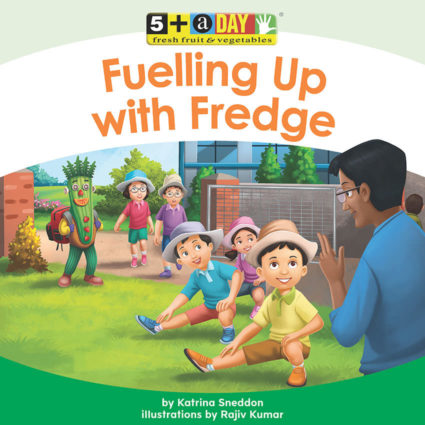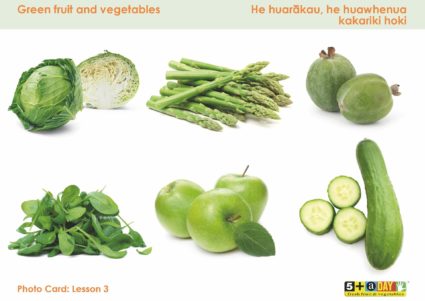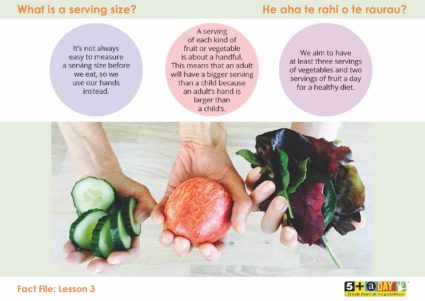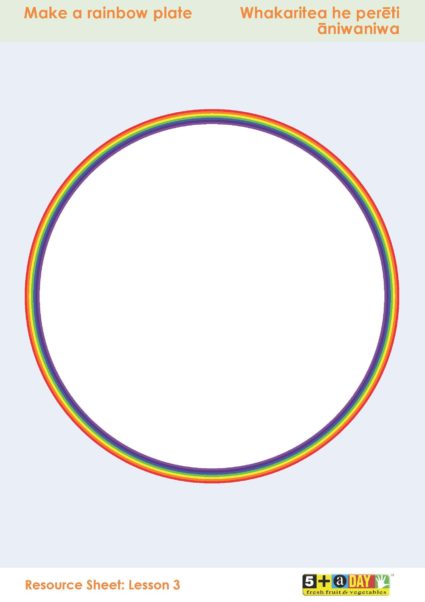Primary
Lesson 3: Eating a Rainbow
This is the first of two lessons in which students can explore the importance of eating a rainbow of different coloured vegetables and fruit to keep their bodies healthy and ready for exercise. This will lead to a second lesson where students will create a one-week plan to prepare for playing a sport at the beginning of the season.


This lesson is featured in our printed resource; Book 1: Growing and Learning with 5+ A Day, Levels 1 & 2.
Order the print version here or download here to print yourself.
Learning Intentions
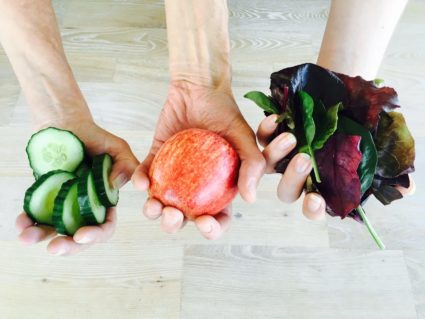
Students will:
- discuss the importance of eating a rainbow of fruit and vegetables to stay healthy
- understand serving sizes
- explore how we prepare for playing sport or doing exercise
- encounter and use Māori terms for scientific objects and processes.
Possible Achievement Objectives
Health and Physical Education: Levels 1 & 2
SOCIETAL ATTITUDES AND VALUES
Students will:
- explore how people’s attitudes, values, and actions contribute to healthy physical and social environments.
SAFETY MANAGEMENT
Students will:
- identify risk and use safe practices in a range of contexts and identify people who can help.
REGULAR PHYSICAL ACTIVITY
Students will:
- participate in creative and regular physical activities and identify enjoyable experiences.
Health and Physical Education: Level 2
PERSONAL GROWTH AND DEVELOPMENT
Students will:
- describe their stages of growth and their development needs and demonstrate increasing responsibility for self-care, for example, in relation to their exercise needs, learning needs, nutritional needs, and social needs, the preparation of snack food, appropriate clothing, digestion, expressing their feelings, hygiene, personal medication, and relaxation.
Preparation
What You Need
- eBook: Fuelling Up with Fredge
- Fact File: All about fruit and vegetables/He kōrero katoa mo ngā huarākau me ngā hua
whenua - Photo Card: Green fruit and vegetables/He huarākau, he huawhenua kakariki hoki
- Photo Card: Other coloured fruit and vegetables/ Ētahi atu hua rākau, ētahi atu huawhenua ā-tae
- Fact File: What is a serving size?/He aha te rahi o te raurau?
- Resource Sheet: Make a rainbow plate/Whakaritea he perēti āniwaniwa
- Some fruit and vegetables to illustrate serving sizes (small potato, small orange, handful of cherry tomatoes)
- Old magazines and newspapers and supermarket flyers with coloured pictures of fruit and vegetables
- Scissors
- Glue
Additional Resources
- Tons of Tomatoes by Bronwen Wall (School Journal, Level 2, November 2014) https://tinyurl.com/jb2unnr
Key Vocabulary
These words are important to this lesson, and can be defined and explored in context as you discuss the topic with your students. A number of content words are provided in English and Māori. Introduce terms in both languages as appropriate.
serving/raurau: the amount of food (a handful) that represents one serve of fruit or vegetables
vitamins/huaora: found in food, they are made by plants and animals, and they help your body grow and stay healthy
minerals/kohuke: found in food, they come from the soil and water, and they help your body grow and stay healthy
fibre/weu: helps with digestion and helps prevent disease
glucose/kuhuka: a type of sugar in the blood; it provides energy
Learning Opportunity
This lesson will introduce students to the topic of eating 5 or more servings of fresh fruit and vegetables every day as part of balanced eating in order to be fit and healthy, and the importance of eating a rainbow of coloured fruit and vegetables.
The Lesson
eBook: Fuelling Up with Fredge
Begin the lesson by sharing the eBook, Fuelling Up with Fredge (click on the cover of the eBook).
There is audio for this story that you can use, or students can take turns to read the text
The messages in this eBook introduce the topic of making good food choices and eating healthily when you are exercising. For information on using 5+ A Day eBooks, click here.
There are two interactive activities that follow the eBook. They work on a computer, a tablet, or an IWB. They can be used during or at the end of the lesson or in choosing time to reinforce key information from the story. Students will get the most from these activities if you model them first and explain the actions required and the aims of the activity. Then students can do them independently or in pairs.
For Activity 3, help Tama eat 5 or more servings of fresh fruit and vegetables every day by dragging two servings of fruit and three servings of vegetables onto the plate. Support the students to understand that half the plate should be filled with fruit and vegetables. For Activity 4, click on the dice and throw a 3, 5, or 2 to enable Tama and the children to play 5+ A Day football.
Key messages from the eBook
After you have read Fuelling Up with Fredge together, talk about the key messages in the story: Just like a car needs the right kind of fuel to run well, your body needs good fuel (food) to help you exercise or go for a run.
- What happened to Tom and Kayla during the run? (pages 6 and 7) (They got puffed and had to walk.)
- Has this happened to you when you’ve been exercising?
- Why do you think the children ran out of energy? (They hadn’t eaten the right kind of food for doing a run.)
- What do you eat before you exercise or play sport?
- What things did the children say they need to do before exercise? (Drink plenty of water, do stretches, and eat healthy food like plenty of fruit and vegetables.)
- What do you do before you exercise?
Discuss the importance of eating fruit and vegetables every day to stay healthy.
- Fredge talked about the importance of eating plenty of fresh fruit and vegetables. It’s important to eat 5 or more servings of fresh fruit and vegetables every day. What fruit do you like to eat?/He aha ngā huarākau pai ki a koe?
- What vegetables do you like to eat?/He aha ngā huawhenua pai ki a koe?
Fact File: All about fresh fruit and vegetables/He kōrero katoa mo ngā huarākau me ngā hua whenua
Now show the children the Fact File: All about fresh fruit and vegetables/He kōrero katoa mo ngā huarākau me ngā hua whenua (click on the image to enlarge, download, and print).
Then discuss the kinds of fruit and vegetables the children bring in their school lunches.
- What vegetables do you eat at school?/He aha ngā huawhenua ka kaingia e koe i te kura?
- What fruit do you eat at school?/He aha ngā huarākau ka kaingia e koe i te kura?
- What are your favourite fruit and vegetables?/He aha āu tino huawhenua, āu tino huarākau hoki?
Photo Card: Green fruit and vegetables/He huarākau, he huawhenua kakariki hoki
Show the students the Photo card: Green fruit and vegetables/He huarākau, he huawhenua kakariki hoki (click on the image to enlarge, download, and print).
- What do you notice about these fruit and vegetables? (They are all green.)/He aha o kitenga ki ēnei huarakau, huawhenua hoki? (He kākāriki te katoa.)
- What fruit and vegetables do you see?/He aha ngā huarakau, me ngā huawhenua ka kitea?
- Does your mum or dad ever say "Eat your green vegetables"?/Ka whāki o mātua kia kaingia āu huawhenua, āu huarākau hoki?
Brainstorm with the students other green fruit and vegetables they know. Explain that vegetables with green leaves like spinach, broccoli, and lettuce are packed with minerals and vitamins. Some of these help our bodies grow or stop us from getting sick.
Photo Card: Other coloured fruit and vegetables/Ētahi atu hua rākau, ētahi atu huawhenua ā-tae
Now show the students the Photo Card: Other coloured fruit and vegetables/Ētahi atu hua rākau, ētahi atu huawhenua ā-tae (click on the image to enlarge, download, and print).
- What do you notice about these fruit and vegetables? (They are different colours.)
- What fruit and vegetables can you see?
Brainstorm with the students other coloured fruit and vegetables they know like blueberries, red apples, peaches, red capsicum, pumpkin, beetroot, and carrots. Explain that these coloured fruit and vegetables also contain different vitamins and minerals that help us think, work, and play during the day.
Remind the students about eating 5+ A Day (eating five or more servings of fresh fruit and vegetables every day).
- So now we’ve learned about how good fruit and vegetables are for us and that it’s important to eat 5 or more servings a day, we’re going to talk about what a serving size is.
Fact File: What is a serving size?/He aha te rahi o te raurau?
Introduce the concept of a serving size by showing and discussing the Fact File: What is a serving size?/He aha te rahi o te raurau? (click on the image to enlarge, download, and print) with the students.
Hold out your hand to illustrate a handful and then ask the students to hold out their hands.
- This is a handful./He ringa pohapoha tēnei.
Then take the fruit and vegetables you have brought in and hold each one or group in your hand. Pass around the vegetables and fruit and the students can take turns holding each vegetable or fruit to see how it fits in their hands.
The students can now do Activity 3 that follows the eBook, independently or in pairs, and help Tama to eat 5+ A Day.
Reflect on the Learning
This is the time to reflect on the learning outcomes for the lesson. It is also a time for students to talk about and share ideas that are still unclear. In reflecting on this lesson, focus the discussion on the importance of eating a rainbow of fruit and vegetables to fuel up for exercise.
To reinforce the learning, the students can use Resource sheet: Make a rainbow plate/Whakaritea he perēti āniwaniwa (click on the image to enlarge, download, and print) to make a plate of fruit and vegetables in a rainbow pattern.
What are the colours of the rainbow? (red, orange, yellow, green, purple)/He aha ngā tae o te aniwaniwa? (whero, karaka, kōwhai, kakāriki, waiporoporo)
Hand out the magazines and newspapers and ask the children to cut out pictures of different coloured fruit and vegetables to paste on to the plate in a rainbow pattern.

